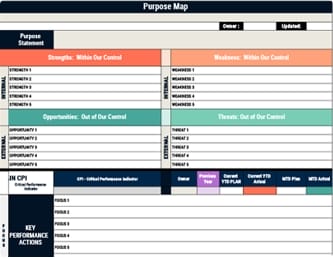To build a Business Operating System (BOS) that truly works, you’ll need to take a systematic approach, beginning with an assessment of your current business processes and involving your team to clarify roles. By utilizing tools like project management software, you can streamline communication, ensuring everyone has access to essential information. It’s crucial to establish a regular review process to embrace continuous improvement, which will help align your BOS with organizational goals and adapt to feedback effectively.
Key Takeaways
- Conduct a comprehensive assessment of current processes to identify inefficiencies and areas for improvement.
- Involve team members in defining roles and responsibilities, ensuring processes are transparent and accessible.
- Establish a cyclical review process for continuous evaluation and refinement of the BOS.
- Utilize business operating software and knowledge management tools for streamlined operations and consistent information access.
- Engage external coaching and involve team feedback to optimize the BOS and align with organizational goals.
Understanding the Basics of a Business Operating System
A Business Operating System (BOS) is essential for any organization looking to streamline its operations and ensure consistent performance across all departments.
Understanding the basics begins with recognizing that a BOS is a documented framework outlining how your business operates. It provides a common language for roles, responsibilities, and processes.
The key components of a BOS include processes, systems, roles, skills, and structure. These elements create a cohesive operational strategy that enhances efficiency and effectiveness in your business operations.
Processes, systems, roles, skills, and structure unify to boost operational efficiency and effectiveness.
Team members play a vital role in this system by engaging in defining roles and responsibilities, ensuring processes are well-documented and accessible.
This collaboration, coupled with business operating software, streamlines communication and aligns your organization with its overarching goals.
Recognizing the Need for a BOS in Your Organization
Ever wondered why your organization seems to be constantly putting out fires rather than making strategic advancements? You might need to identify the need for a Business Operating System (BOS).
As a business owner, recognizing chaotic workdays and unexpected issues disrupting tasks is crucial. These signs indicate the need for structured decision-making and a more cohesive company culture.
A BOS can enhance communication flow, ensuring everyone is aware of organizational happenings. It also defines roles clearly, fostering accountability among coworkers.
High turnover rates often reflect an unproductive work environment, which a BOS can remedy by creating a structured framework.
Lastly, if increasing sales aren’t translating to value creation, aligning objectives through a BOS can help drive success.
Key Benefits of Implementing a Business Operating System
Addressing the chaos and inefficiencies that signal the need for a Business Operating System (BOS) leads directly to the significant benefits it offers once implemented.
A well-structured BOS enhances operational efficiency by clearly defining roles and responsibilities, which fosters accountability and measurable results. This clarity reduces time wasted on communication issues, saving substantial costs—as much as $528,443 annually for companies with 100 employees.
Furthermore, BOS aligns operational tasks with company goals, ensuring each effort contributes to strategic objectives. It simplifies complex processes, enhancing work quality and speeding up project execution.
Essential Components of a Successful BOS
When you’re building a successful Business Operating System (BOS), understanding its essential components is crucial for crafting a cohesive and efficient framework.
Start by clearly defining Processes, which outline the step-by-step actions needed to complete tasks, ensuring consistency and quality.
Next, focus on Systems, encompassing the tools and technologies that facilitate these tasks; they should be well-documented and accessible to boost efficiency.
Clearly articulated Roles are vital, assigning distinct responsibilities to individuals to prevent overlap and foster accountability.
Identify the necessary Skills for each role, ensuring team members possess the expertise needed to perform effectively.
Together, these elements align human resources with your organizational goals, creating a robust BOS that supports your business’s success.
Steps to Develop a Custom BOS for Your Business
Developing a custom Business Operating System (BOS) for your business begins with a thorough assessment of your current processes, as this step lays the groundwork for a more efficient and streamlined operation.
Start by identifying areas that need improvement, helping make your company more effective. Involve team members by clearly defining roles and responsibilities to boost accountability and align everyone with the company’s goals.
Identify improvement areas, define roles, and align team members to boost accountability and effectiveness.
Document these processes and ensure they’re accessible to all, promoting transparency and consistency. Implement business operating software like Ninety to enhance communication, streamline operations, and track progress.
Establish a cyclical review process to continuously evaluate and refine your BOS, focusing on defining targets, executing plans, evaluating results, and improving based on performance metrics.
Engaging Stakeholders in the BOS Development Process
How do you ensure that your Business Operating System (BOS) aligns with the needs and expectations of everyone involved?
Start by engaging stakeholders throughout the BOS development process to include diverse perspectives, fostering greater buy-in and commitment.
Clearly define roles and responsibilities, allowing team members to feel a sense of ownership and accountability, which is crucial for successful implementation.
Maintain regular communication about the BOS’s goals and benefits to align expectations and highlight how their contributions impact organizational success.
Conduct feedback sessions to gather valuable insights, identifying potential weaknesses and ensuring the BOS is relevant to your organization’s needs.
Implement a structured involvement plan, incorporating workshops and feedback sessions, to ensure stakeholders’ voices are heard and valued throughout development.
Utilizing Business Operating Software for Efficiency
Integrating business operating software into your Business Operating System (BOS) can significantly enhance your organization’s efficiency by streamlining operations and minimizing manual tasks.
By adopting a suite of tools like Ninety’s cloud-based platform, you’re building a Business Operating that focuses on efficiency and strategic goals.
Here’s how it can help:
- Automate Routine Processes: Reduce manual effort, allowing your team to focus on more critical tasks.
- Real-Time Analytics: Track key performance metrics to make informed decisions quickly.
- Centralized Communication: Decrease miscommunication, saving an estimated $528,443 annually for 100-employee companies.
- Foster Accountability: Enhance collaboration and accountability among team members, strengthening company culture.
You’ll need to make choices that align with your strategic objectives, ensuring the software meets your specific requirements.
Strategies for Effective Communication and Implementation
To enhance your Business Operating System’s efficiency, the next step involves crafting strategies for effective communication and implementation.
Start by developing a comprehensive communication plan that outlines protocols for informing all organizational levels, ensuring consistent messaging. Engage team members in defining roles and responsibilities to foster a collaborative culture, ensuring everyone understands their contributions to the organization’s goals.
Develop a communication plan and define roles to ensure consistent messaging and a collaborative culture.
Regular meetings, like the Level 10 Meeting™, maintain structured agendas that facilitate discussions and accountability, supporting the BOS framework. Implement tools like Ninety’s software to streamline processes, track goals, and maintain transparency.
Additionally, conducting a SWOT analysis identifies strengths, weaknesses, opportunities, and threats, allowing for informed BOS adjustments. These strategies ensure effective communication and successful implementation of your BOS.
Continuous Improvement and Adaptation of Your BOS
Even though your Business Operating System (BOS) may be functioning well now, embracing continuous improvement ensures it remains effective and relevant in an ever-changing market.
To achieve this, focus on adaptation by engaging in regular evaluation and refinement of your processes. Implement a feedback loop to encourage team members to report inefficiencies or suggest enhancements. Use performance metrics to track progress and identify areas needing adjustment. Schedule regular reviews, like quarterly assessments, to keep your BOS aligned with evolving goals.
Here’s how you can do it:
- Establish a feedback loop: Encourage suggestions and reports on inefficiencies.
- Utilize performance metrics: Track progress and pinpoint improvement areas.
- Conduct regular reviews: Schedule assessments to stay aligned with goals.
- Engage employees: Foster collaboration and adapt to changes effectively.
Leveraging Tools and Resources for BOS Success
Successfully leveraging tools and resources can significantly boost your Business Operating System‘s (BOS) effectiveness and efficiency. Implementing business operating software like Ninety helps streamline operations by enhancing communication and automating tasks, making BOS implementation smoother.
Utilizing a centralized knowledge management tool such as Tettra ensures all employees access consistent, updated information, reducing miscommunication costs. Regularly updating your internal wiki keeps processes relevant, boosting organizational efficiency.
Tools for team collaboration, like project management software, align your team with organizational goals, ensuring everyone’s informed. Engaging with external coaching provides insights and strategies to optimize your BOS, improving decision-making and accountability.
Frequently Asked Questions
How to Build a Business Operating System?
To build a business operating system, start by evaluating your current processes, pinpointing areas for improvement.
Engage your team to define roles and responsibilities, fostering accountability.
Document every process clearly, ensuring everyone can access and follow them.
Implement software like Ninety to streamline operations and improve communication.
Regularly assess and refine your system through cycles of setting targets, executing plans, and reviewing outcomes, ensuring continuous improvement and adaptability.
How to Build a System That Works?
To build a system that works, first identify weaknesses like a detective seeking clues, involving all relevant parties to ensure comprehensive understanding.
Clearly define roles to promote accountability and smooth collaboration. Document processes clearly, ensuring everyone’s on the same page.
Use effective software to track and communicate goals. Regularly review and refine system components to stay aligned with strategic objectives, fostering continuous improvement and ensuring the system’s ongoing effectiveness.
How to Build a Successful Business System?
To build a successful business system, start by evaluating your current processes to identify areas for improvement.
Engage your team to clearly define roles and responsibilities, ensuring alignment with company culture and growth objectives.
Document these processes comprehensively, making them accessible to all stakeholders to prevent confusion.
Use business operating software to enhance communication and task automation.
Regularly review and adjust your system to maintain alignment with goals and adapt to changes.
How to Build Effective Systems?
To build effective systems, start by defining clear, consistent processes that ensure tasks are easily replicable.
Use specific tools and technologies designed for each team’s needs to enhance workflow and productivity.
Document these systems in a centralized knowledge base, like an internal wiki, for easy access.
Regularly assess and update the systems to keep them relevant.
Engage team members in the process to ensure the system aligns with their roles and fosters a sense of ownership.
Conclusion
To build a Business Operating System that truly works, recognize its potential to transform your organization by clarifying roles, streamlining processes, and fostering communication, much like a conductor orchestrates a symphony. Embrace tools like project management software to enhance efficiency while ensuring everyone is aligned with organizational goals. Remember, continuous improvement isn’t just a goal—it’s a necessity; regularly review and adapt your BOS to feedback and performance metrics to maintain its effectiveness and drive sustained success.



